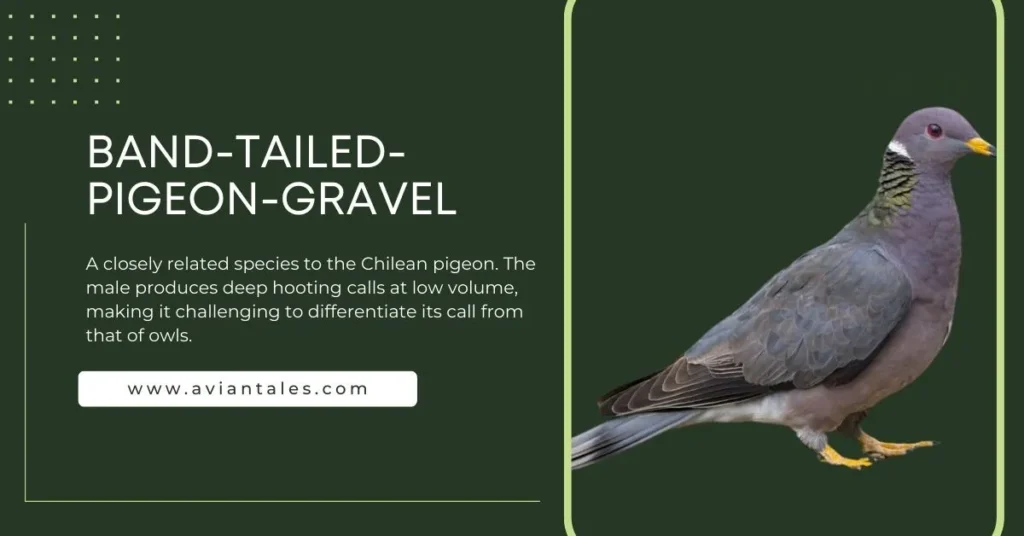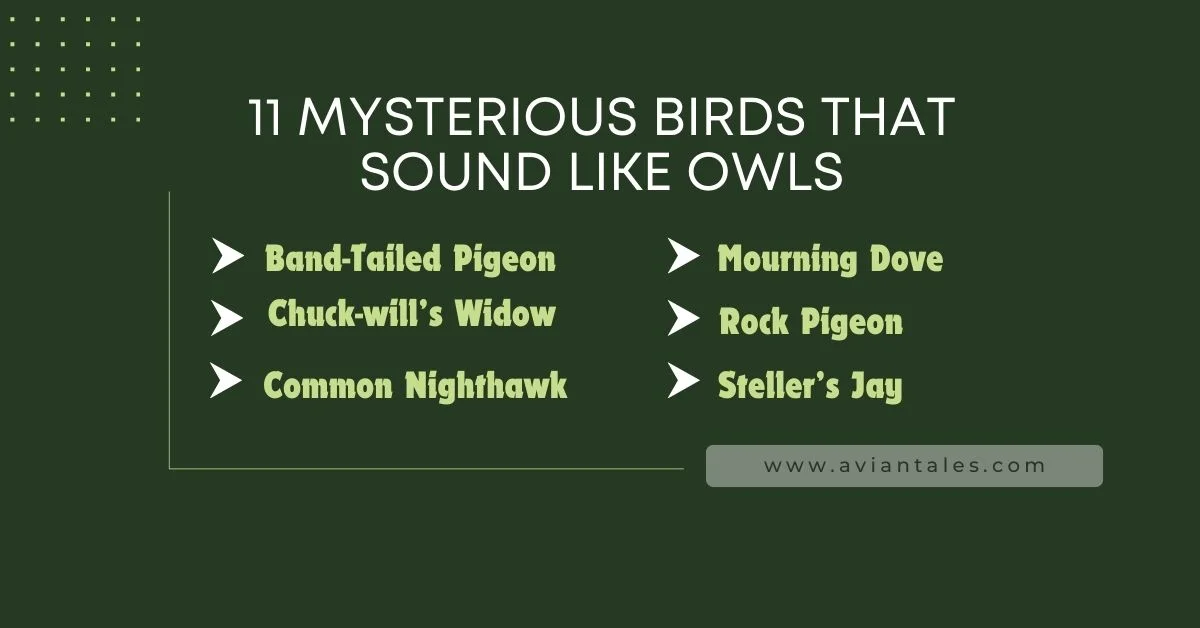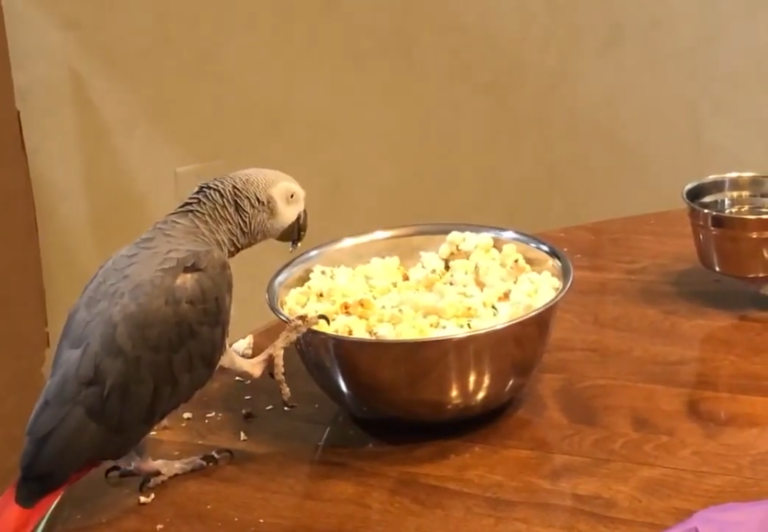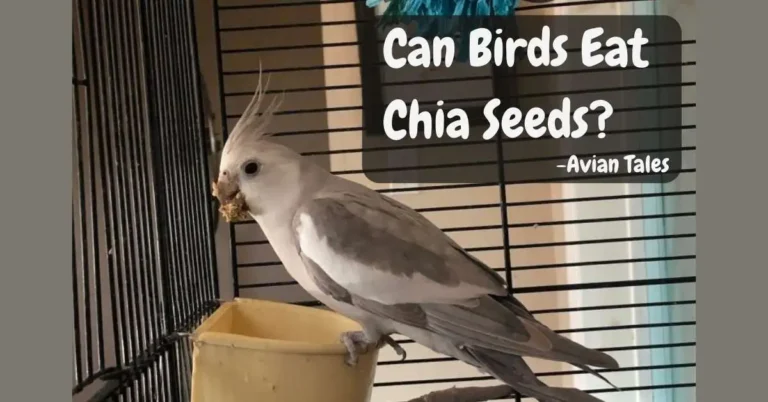11 Mysterious Birds That Sound Like Owls
Are There Other Birds That Sound Like Owls?
Have you ever heard the hoot of an owl and thought it couldn’t be an owl? At this point, you are right because some birds sound like owls. Mourning Dove, Western Nightjar, Steller’s Jay, Wilson’s Snipe, Tawny Frogmouth, Rock Pigeon, and others are known for their owl-like sounds.
Owls are famous for hooting at night, but they sometimes hoot during the daytime to meet their needs. In addition to hooting sounds, they produce other noises, such as screams, while searching for food or protecting their territory. Owls also whistle, shriek, coo, hiss, and cry and are famous for their nocturnal nature. Finding owls in urban habitats is challenging, as you rarely see them in such locations. Consuming owls is prohibited in most countries.
This majestic bird produces sounds often misidentified with other birds, primarily nocturnal birds like Nightjars. If you love birds and their sounds, you will quickly differentiate the sounds of owls from other birds, keeping in front of the time and the sound patterns.
Are you curious about the other bird whose sounds are often confused with the owls? If so, you are in the right spot! Here, you will discover those majestic birds. Let’s start the journey without delaying it.
Band-Tailed Pigeon
A closely related species to the Chilean pigeon, the Band-tail pigeon is native to South and North America. The male produces deep hooting calls at low volume, making it challenging to differentiate its call from that of owls. Moreover, in contrast to owls, male pigeons usually don’t call at night.

Chuck-will’s Widow
Chuck-will’s-widow is another bird that belongs to the nightjar family. Its nocturnal cooing confuses you with the owl hooting at Nighttime. They commonly visit southeastern parts of the United States. These are rarely seen in cities and are found in pinewood trees and forested regions. Thor produces sounds, resembling other birds in their family, such as eastern and western nightjar.

Common Nighthawk
This American bird comes under the family of nightjar. They are known because they produce hotting calls similar to owls. To differentiate between the call of owls and nighthawks, focus on the pattern of the call. Nighthawk call includes a distinctive nasal popping sound (called peent).
Did you know Birds can Transmit Diseases to Human

Mourning Dove
Mourning doves are commonly found in regions like Central America, Mexico, the United States, and some parts of Canada. They are also seen in crowded areas like Manhattan, inside small ventilation zones of skyscrapers. People in these areas may be confused by the daytime hooting of owls or intense hooting calls throughout the day. The fact is that most of the time, it is just a flock of morning doves rather than an owl.
A question arises: how do we differentiate an owl Call from a Mourning Dove sound? Let me explain! Undoubtedly, it is almost impossible to distinguish the sound of an owl and a mourning dove.
- But the thing that will help you is the starting sound these birds produce. Morning Dove mostly starts with a short or long “coo” sound compared to a “woo” call like an owl hoot.
- The other thing is mourning dove hoots during daytime and in the form of groups. Owls usually prefer a solitary life, except during their mating season, so finding their bunch in your busy areas is challenging during daylight.
Rock Pigeon
Rock pigeons, also called rock doves, are found worldwide, but their ancestors came from Asia and Europe. The sounds of these domesticated birds differ from those of owls, but they produce a grunting noise; just like owls, they are threatened by predators. Sometimes, their deep coos with bowing and strutting calls confuse you.
Steller’s Jay
You may have confused Steller’s Jay call with a barn owl. In contrast to other subspecies of owls, barn owls mostly live in abandoned buildings. They produce long screech calls instead of hoots and whines. People often misperceive them as cardinals.
Steller’s Jay is common in North America and produces a similar screechy call. To differentiate their calls from owls, you can use two methods.
- First, Steller’s jay is heard during the daytime, while the barn owl is nocturnal.
- Second, Barn’s owl possesses a huskier tone compared to Steller’s jays.
Western Nightjar
Nightjars are also among birds whose sounds resemble those of owls. The nocturnal nature of both birds is the main reason for this confusion. An expert ear can tell whether the sound is of a nightjar or owl.
To learn about the nightjar call, focus on the duration because they chirp and can hoot continuously for hours. In contrast, owls can never be as persistent and loud as Nightjar. The Western Nightjar, also called common poorwills, mostly heard their whistling at nighttime.
Whip-Poor-Will
Whip-Poor-Will belongs to the family Nightjar and is commonly found in North America. You may not spot one because the brown and grey coloration camouflages it effectively in tree trunks. The name Whip-Poor-Will comes from the distinct pattern of its call. Their quavering sound is often heard on summer nights in the central US.
Wilson’s Snipe
Whilson’s Snipe commonly visits North America, particularly during mating season. While migrating, Wilson’s snipe also visited the Southern United States and Central America.
They form sharp and different sounds from owls, but one can be confused by the sound produced by the male Wilson snipe to attract females. You may think that an owl’s hoot might be the noise from its feathers.
Tawny Frogmouth
Tawny Frogmouth are native to the Australian mainland but can be spotted throughout the continents. Even though they resemble owls in appearance, their call is like that of a boobook’s call. They are not very talkative; they hiss and buzz only in the presence of predators.
Other Doves
Hooting coo is the characteristic of all the members of the dove family. You can easily differentiate their sound from owls if you have heard owls before. Doves, excluding rock doves and mourning doves, periodically make a noise resembling an owl’s hoot.
Owls live in silent areas like abandoned buildings and forests, while doves live in crowded places. Furthermore, owls are nocturnal, but doves are diurnal. These factors make it easy to differentiate their calls.
FAQS
Which bird produces a hoo hoo hoo sound?
The great horned owl are known for their hoo hoo hoo sounds.
What animal makes a weird sound at night time?
Nocturnal animals such as coyotes, rats, raccoons, and lizards are active at night. They perform daily life rituals like mating, hunting, and nesting at night.
What do owls sound like, “Who cooks for you”?
Barred Owl produces a 9 note, which sounds like “Who cooks for you?”
Final Thought
Owls are nocturnal and produce deep stuttering calls at night in abandoned areas. It is challenging to distinguish their hoots from other birds, especially those of the Nightjar family, as they are nocturnal too.
Many birds, such as Mourning doves, western nightjar, rock pigeons, tawny frogmouth, common nighthawk, and steller’s Jay, hoot like owls. But there are some ways by which we can differentiate their calls from each other.



